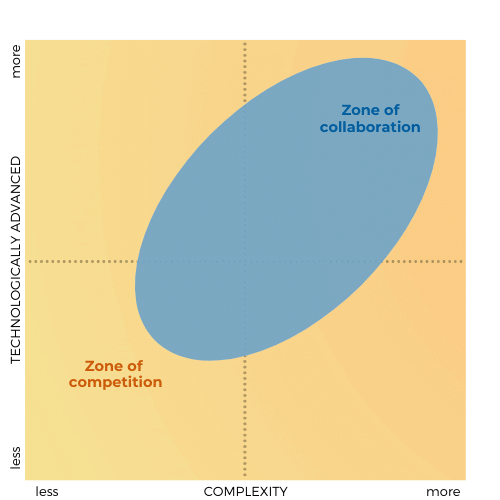
Why collaboration beats competition
Conventional Marketing theory (and common sense) teaches us that, in order to win in business, you have to be better, faster or cheaper than the competition. But does this also hold true for innovation?
On the surface, you would probably say “yes, of course”. If you can deliver innovations better, faster or cheaper (or ideally a combination of these), you are bound to succeed – right? But, as anyone who has ever tried to launch an innovative new product will tell you, it is not always as simple as that.
In fact, the more advanced and more complex your product, the harder it becomes. Nowhere is this truer than with innovations in telecoms and technology, where the environment is already highly complex and your innovation might as soon break something else than succeed on its own. Having to compete for scarce knowledge and resources makes it significantly harder and even reduces the likelihood of succeeding for any one company on its own.
The concept is really quite simple. If your innovation is relatively straight-forward and easy to do, you had better do it better, faster and cheaper than the competition (who has probably
already also thought of it). If, however, it is complex and technologically advanced, it is probably worthwhile having a look around for others who might also be considering this and think about joining forces – potentially even with competitors.

Competitive innovation can take place everywhere, but Collaborative Innovation is more likely in complex and technologically advanced environments
The biggest benefits of collaborative innovation
Collaboration for innovation can take many forms – it can be anything from occasionally sharing some insights to formally collaborating in joint projects.
Collaboration can also deliver many benefits, but we will focus on the top 3:
- Pooling knowledge & resource
- Increased impact
- Higher relevance
Pooling knowledge & resource
The first major benefit is pretty easy to understand. By joining forces, teams that would otherwise work in isolation, suddenly have access to a much bigger, combined knowledgebase and much larger pool of experience. Knowledge and experience – two critical success factors for any innovation, which is bound to make your innovation better. By combining teams, you also increase the resources (people, equipment, funding) and with some effective management, this is bound to make your innovation come to market faster. It should never be more expensive for each participating company and might even be cheaper overall, but even if it is not, delivering 2 out of 3 is not bad!
Increased impact
The second major benefit has to do with scale. By collaborating with others, you are increasing the scale of your whole innovation, which in turn increases the impact you can make in the market. This is easiest to illustrate when you consider developing an innovative product or service collaboratively with competitors (within the legal constraints of anti-trust legislation, of course). Say you launch your innovation on your own, you can only reach your own existing customer base – and perhaps try to add some new ones. If, however, your innovation is launched my multiple companies in your industry, the reach and impact thereof is amplified many-fold. Now, assuming also that the success of your innovation depends on the uptake and usage thereof (which is mostly the case with advanced technology services) it should become clear that collaboration will help your innovation deliver a much bigger impact.
Another, perhaps simpler, way of looking at the increased impact collaboration can offer is to ask yourself whether you would rather have all of a small cake, or a part of a much bigger cake. Quite often a part of a bigger cake can be worth a lot more than all of a smaller one.
Higher relevance
The third major benefit of collaboration might not be as immediately obvious as the others, but can be just as powerful. Increasing the relevance of your innovation could mean the difference between getting stuck (or forced to sacrifice) and success.
Ask yourself two critical questions: (1) “how important is my innovation to my company / to my industry?” and even more importantly (2) “does everyone know and agree that my innovation is important?”. For any passionate innovator, the answer to the first question should always be easy, it is normally the second one where things get more complicated.
If you are innovating inside a company, your innovation will always be competing for management attention and scarce company resources. Even though your innovation is important, it will always be in this internal competition – which might result in critical compromises, or in the worst case, being put on hold or cut. Collaboration raises the internal relevance, smoothing the internal path forward for your innovation.
Collaboration also raises the relevance in the broader ecosystem. If two companies are working together on an innovation, suppliers and service providers will be more interested to support than if it were just one – and the effect is obviously magnified if more companies join.
The 3 biggest benefits of collaborative innovation are: pooled knowledge, increased impact and higher relevance
So, if collaboration is so beneficial, why is it not the dominant mode of innovation? Quite simply because it is not always that easy to implement and there are significant pitfalls one might inadvertently step into on the way.
The next 2 blogposts in this series will explore
the 3 biggest pitfalls of Collaborative Innovation and When to collaborate.
Coming soon… watch this space.

Impatient? Request the full article here:


